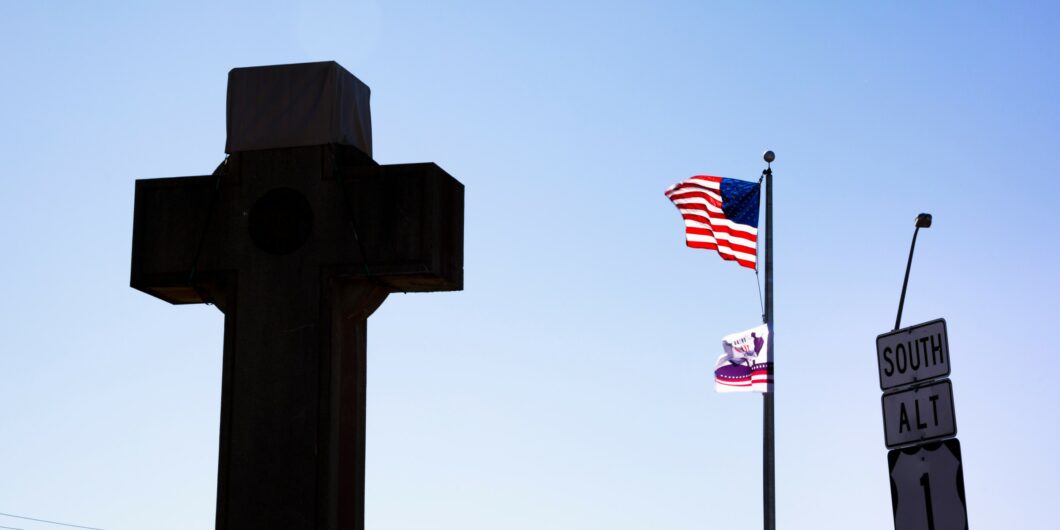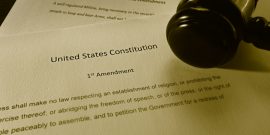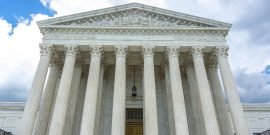Separationism's decline began some 40 years ago, in response to ecumenicalism, social welfare legislation, and the rehabilitation of the Catholic Church.
A Path to First Amendment Pluralism
The worst-understood passage in our Constitution’s Bill of Rights is probably the first: “Congress shall make no law respecting an establishment of religion.” That such a simple provision is the source of so much uncertainty is hardly the fault of regular Americans failing to understand the text’s plain meaning, nor is it due to changes in language that often turn the words of the Constitution into an impenetrable puzzle. Rather, as Michael McConnell and Nathan Chapman show in their outstanding new book, Agreeing to Disagree, blame for muddling the meaning of the Establishment Clause falls squarely on the robed shoulders of Supreme Court justices of the mid-to-late twentieth century. Whether the justices were more confused or confusing is a close competition. More certain is that Americans will have to steady themselves as the current Court moves towards a healthier and historically grounded—yet painfully unfamiliar—interpretation of the First Amendment. Not content to provide the context for the ongoing sea change, McConnell and Chapman argue with concision and common-sense appeal that reading the Establishment Clause as a pluralism-fostering device is both constitutionally authorized and workable.
The authors provide jurisprudential context crucial for framing that argument. Plagued by judge-made tests that proved unworkable, “zombie precedents” whose demise and resurrection make litigation unpredictable, and reliance on the reductive axiom of “separation of church and state,” the Establishment Clause has done a poor job of fostering pluralistic coexistence since World War II. Instead, it has been a source of animosity. As long as the “wall of separation” between church and state was the law of the land—as the Court declared it was in 1947—First Amendment jurisprudence incentivized Americans to characterize opposing views as impermissibly tainted by religious belief rather than argue with them on the merits. Rather than putting religious conflict to rest, the Court’s interpretation of establishment stoked battles between various sects and factions over which beliefs are religious in nature and which are simply common sense. Least workable of all—and completely ahistorically—the Court reshaped the Constitution into a brass ring for secularists who wished to purge American public life of religious symbols and teachings.
In many ways, the Court’s misinterpretation of the Clause was emblematic of everything originalists detested about the activist Court. Rather than rely on long-running traditions that reflected a proper interpretation of the seemingly ambiguous words, the Court decided its first modern Establishment Clause case by cherry-picking one Founder’s (Thomas Jefferson’s) interpretation of the law, which happened to sit well with the Justices’ sensibilities. A secularist crusade took off from there, yielding some anomalous practices. One counterintuitive ruling serves to illuminate the trend: the Court itself begins its sessions by invoking God, but ruled in a 1992 decision that a public school in Rhode Island could not allow a rabbi to give a non-sectarian benediction at a graduation ceremony. Had the Court engaged in legal reasoning, which requires looking to past interpretations to ascertain the meaning of ambiguous phrases, they would have recognized that the Establishment Clause could not have possibly required strict separationism unless one accepts that the Court itself had been violating the Constitution uninterrupted for over a century. But showing little regard for the Constitution’s long-settled meaning, the Court ran with an interpretation guided more by the justices’ own moral philosophy than by the practices of the American people.
It is unsurprising, then, that the Court’s recent unwinding of twentieth-century judicial innovations has been most pronounced in Establishment Clause cases. It has happened piecemeal, but starkly. Public schools were once required to discriminate against religious uses of taxpayer funds; now they are prohibited from doing so. Municipalities were once barred from putting up overtly religious symbols, but the Court ruled in 2019 that a large state-maintained cross paying tribute to military veterans was constitutional. Finally, repudiating the undead Lemon test that barred “excessive entanglement” between religion and state, the Court last year ruled that states must allow public employees to engage in private prayer even when there was a risk that schoolchildren could feel some indirect pressure to participate. Indeed, it would be a violation of the civil servant’s First Amendment rights to interpret the Establishment Clause to mean anything else.
It is similarly unsurprising that the prevailing rationale for the unwinding is rooted in traditionalist interpretation. The Court has been busy overturning erroneous precedent that relied on what McConnell has elsewhere called “moral philosophic” judging, or the idea that constitutional meaning is determined by judges’ sense of what is rational, ethical, or good. What has risen to replace this mode is fairly dubbed “traditionalist.” It draws on long-running practices evident in the historical record as interpretive guides. This makes good intuitive sense: If Americans have consistently opened legislative sessions with prayer, and no one thought this presented an Establishment Clause issue for 150 years, such prayers are probably constitutional. But this approach, like any interpretive method, presents challenges. The biggest is that our corpus of historical evidence is vast and debatable, and does not always lend itself to firm conclusions.
The disestablishmentarian movement was concerned with keeping religious groups free from a meddling state at least as much as it was with keeping religion out of political life.
Enter McConnell and Chapman, the former a Stanford Law-based fixture of the conservative legal academy who spent several years as a federal judge, the latter an expert in constitutional law and theology who teaches at the University of Georgia. That they write at an opportune moment is likely not coincidental. The Supreme Court is essentially working against a blank slate because Establishment Clause jurisprudence was haphazard and bears little relation to what now counts as cognizable legal reasoning. With the rise of tradition-inflected jurisprudence, they ask and answer the key questions for understanding our constitutional traditions: What did establishment and disestablishment mean at the time of the First Amendment’s ratification? What arrangements did it allow before the Court changed the rules decades later? What did Americans understand the First Amendment to prohibit? Importantly, this inquiry is not limited to the text and its semantic meaning, but includes how individuals and institutions actually behave.
With rigorous yet accessible scholarship, the authors marshal plenty of evidence that shows a particular meaning of disestablishment that better accords with the First Amendment’s plain meaning, known by the way it shaped institutional arrangements. Establishment had a legal meaning, and we know what it is from studying the establishment of the Anglican church in England and the ways in which Americans aimed to avoid a similar setup in their republic. Six main elements of impermissible establishment are identifiable: “(1) [State] control over doctrine, governance, and personnel of the church; (2) compulsory church attendance; (3) financial support; (4) prohibitions on worship in dissenting churches; (5) use of church institutions for public functions; and (6) restriction of political participation to members of the established church.” (Two more—“laws prohibiting blasphemy” and “enforcing sabbath observance”—emerged later.) As these suggest, the disestablishmentarian movement was concerned with keeping religious groups free from a meddling state at least as much as it was with keeping religion out of political life. And to the extent that “establishment” was known to have these characteristics, a law prohibiting establishment is far more complex than the simple “separation of church and state.”
McConnell and Chapman suggest that in rejecting religious establishment and its six main manifestations, the framers of the Constitution endorsed a scheme that stood for a theory of social cooperation: The “historic purposes of the First Amendment” were to foster “religious pluralism” and disavow “religious uniformity.” Establishment meant non-neutrality between sects, treating one or more better or worse than others. But governments composed of mortal men are not competent or authorized to meddle with “spiritual affairs,” and importantly should avoid being the arbiters of religious truth. Instead, they should let each faction “flourish according to the zeal of its adherents and the appeal of its dogma,” as the Court put it in a rare moment of clarity in 1952. Disestablishment and neutrality require the government to abstain from putting a thumb on the scale in the great ongoing debates about human nature and human purpose.
Importantly, though, a principle of non-interference and neutrality between sects does not mean that the state is antagonistic to any sect or to religion altogether. On the contrary, neutrality between sects is meant to allow all to flourish. This is the important distinction between separationism—which has mistakenly been touted as the best way to advance pluralism—and pluralism itself. By deeming religious behaviors and beliefs incompatible with public life, separationism denigrates traditional religion at the expense of secular belief systems. Pluralism is when a rabbi can offer a benediction at a public-school graduation as freely as any American who would speak about the value of liberation, equity, and justice.
But what about coercion? The authors share the Supreme Court’s ongoing concern that indirect coercion should factor into Establishment Clause analysis, especially where children are involved. They take it as a given that religious minorities or dissenters will feel coerced to violate their consciences if authority figures invoke religion in ways that would leave dissenters feeling like outsiders, in school prayer cases, for instance. But this may be a bit too charitable to separationist assumptions. It may rather be the case that our pluralistic muscles have so atrophied that we cannot fathom a culture in which even children are unashamed to stand apart from their peers and teachers. A renewed culture of pluralism could shift our perceptions of what constitutes coercion.
The coercion the authors take for granted may not be so fixed. It may instead be part of a vicious cycle of Americans telling themselves that religious difference is something to stifle, rather than discuss, explore, and celebrate.
On this front, perhaps some perspective from this yarmulke-wearing Jewish reviewer is indicated. My whole life has been spent standing apart from the mainstream in a distinctly religious way. Before hearing the national anthem at baseball games, I do not remove my hat, because Orthodox Judaism considers covering the head, rather than uncovering, a sign of respect. I learned that distinction from the earliest days my father and I would spend at Shea Stadium when I was just a small child. I have spent lots of time in majority-Christian settings, where my peers and teachers would pray together with me in the room, and I did not clasp my hands or bow my head. Of course, I also did not disturb or disrespect my peers’ rituals. As a dissenting Justice Scalia wrote in the Rhode Island case, “Surely our social conventions have not coarsened to the point that anyone who does not stand on his chair and shout obscenities can reasonably be deemed to have assented to everything said in his presence.”
By the time I got to college and law school, where all the social events took place on Shabbat (or offered only non-kosher food), brushing off the fleeting sense of needing to fit in was natural. None of this bespeaks any kind of unusual courage. Just the opposite: Non-Jews invariably came to the same conclusion as the Detroit Free Press did nearly a century ago when Tigers star first baseman Hank Greenberg sat out a crucial game on Yom Kippur: “He’s true to his religion—and I honor him for that!”
The coercion the authors take for granted may not be so fixed. It may instead be part of a vicious cycle of Americans telling themselves that religious difference is something to stifle, rather than discuss, explore, and celebrate. In a culture where we are trained in pluralism—where even children understand that not everyone needs to worship, speak, and act as we do yet are understood as equal citizens—the barest sectarianism is not implicitly coercive. This Jew, for one, will continue to hold out hope that our culture rises to meet the challenge of pluralism.
Agreeing to Disagree concludes with a provocation worth contemplating. Under originalist theory, non-arbitration between truth claims under the First Amendment must be limited to that which was called “religious” in 1791, or is analogous to it. Either religion means those faith systems that existed at the time, or those systems of belief that share their essential characteristics. Nowadays, with faiths in non-traditional gods staking their own claim to ultimate truth and purpose, threats to pluralism emanate from what the authors call “secular and ideological establishments.” What would it mean for the lessons of disestablishment to apply to ongoing efforts “to promote uniformity of sentiment on nonreligious matters: compulsory instruction of state-approved values in public education; the use of taxes to support private organizations devoted only to the dissemination of those values … and the restriction, directly or indirectly … of the ability of dissenting groups to speak, publish, associate and participate in public life”?
It would mean, at least, that we citizens must be zealous in ensuring that the state is stopped in its tracks whenever it tries to advance “uniformity in matters of opinion.” McConnell’s and Chapman’s work is instructive not simply for showing how a traditionalist-originalist Court can and ought to forge a better doctrinal path for the First Amendment, but also for showing why and how Americans attuned to its pluralist aims can bring it to life.


